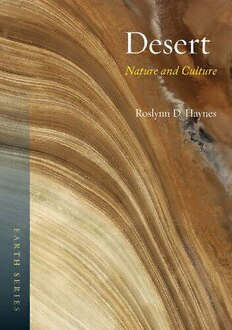
Desert: Nature and Culture PDF
Preview Desert: Nature and Culture
desert The Earth series traces the historical significance and cultural history of natural phenomena. Written by experts who are passionate about their subject, titles in the series bring together science, art, literature, mythology, religion and popular culture, exploring and explaining the planet we inhabit in new and exciting ways. Series editor: Daniel Allen In the same series Desert Roslynn D. Haynes Earthquake Andrew Robinson Fire Stephen J. Pyne Flood John Withington Volcano James Hamilton Waterfall Brian J. Hudson Desert Roslynn D. Haynes reaktion books For my husband Raymond and our daughters Nicola and Rowena, who have shared my fascination with deserts Published by Reaktion Books Ltd 33 Great Sutton Street London ec1v 0dx, uk www.reaktionbooks.co.uk First published 2013 Copyright © Roslynn D. Haynes 2013 All rights reserved No part of this publication may be reproduced, stored in a retrieval system, or transmitted, in any form or by any means, electronic, mechanical, photocopying, recording or otherwise, without the prior permission of the publishers Printed and bound in China by Toppan Printing Co. Ltd. A catalogue record for this book is available from the British Library isbn 978 1 78023 169 3 contents Preface 7 1 The Diversity of Deserts 11 2 An Armoury of Adaptations 39 3 Desert Cultures Past and Present 65 4 Museums of Our Ancestors 88 5 Desert Religions 108 6 Travellers and Explorers 125 7 Deserts of the Imagination 151 8 Deserts in Western Art 175 9 Exploitation and Opportunity 197 the world’s major deserts 210 glossary 213 references 217 select bibliography 232 associations and websites 235 acknowledgements 237 photo acknowledgements 238 index 241 Preface The grandeur of deserts derives from their being, in their aridity, the negative of the earth’s surface and of our civilized humours. They are places where humours and fluids become rarefied, where the air is so pure that the influence of the stars descends direct from the constellations . . . a silence that exists nowhere else. Jean Baudrillard, America(1986) ‘Desert’ is not an innocent term. Geographically it is defined in terms of rainfall, but unlike other landforms there is, inbuilt in its very name, a sense of foreboding. The English word ‘desert’ and its equivalents in the Romance languages all derive from the Latin desertum, meaning ‘abandoned’, which is also the sense of the Egyptian tesert. In Hindi the original meaning of the word for desert, marustahal, was ‘a place of death’, and the name of the Taklamakan Desert is most likely the Uyghur version of an Arabic word meaning ‘a place to leave alone’. Given the strong probability in deserts of dying from heat, cold, starvation or thirst, or of becoming disoriented and lost, these connotations are unsurprising. Deserts also threaten the inner self. Their immensity, solitude and silence pose questions about identity and meaning that are not easily dismissed. As the British explorer Ernest Giles (1835– 1897) wrote of his experience in the Australian desert: I felt somewhat lonely and cogitated that what has been written or said by cynics, solitaries, or Byrons of the delights of loneliness, has no real home in the human heart. Nothing could appal the mind so much as the contemplation of eternal solitude.1 Yet for many people deserts have been intensely alluring. For the Old Testament prophets and the Desert Fathers they were Sossusvlei salt pan, Namib Desert, 2009. places of purification and spiritual renewal; explorers have sought 7 desert out deserts ‘for the burning charm of seeking something new’ and to be the first to set foot there;2for travellers, the attraction is often the challenge of life at the edge, braving extremes of heat, cold and endurance, or discovering a place to regain simplicity and a sense of priorities; for artists, deserts mean brilliant colours, simplified forms and clarity of vision;for astronomers, they pro- vide the dry atmosphere that grants them the best observing conditions from Earth; for writers, they represent silence, soli- tude, the edge of the sacred; for many indigenous peoples, desert is home. This book explores the great diversity of the world’s deserts, hot, cold, coastal, inland, sandy, rocky and salt, and includes the largest desert of all: ice-bound Antarctica. We know now that on a geological time scale, deserts are transitory: they have appeared and disappeared, leaving a trail of intriguing evidence, from marine fossils to cave paintings, that tells us about their former state. Even more diverse than deserts themselves are the astonish - ing adaptations of plants and animals to these life-threatening environments, and the human societies that have managed to survive here, leaving records of their life in art and in millennia- old mummies, but almost everywhere experiencing new hardships in their economic and political struggles. Equally intriguing is the question of why the world’s great monotheistic religions all arose in the desert and what influence, if any, the ethical values ascribed to it continue to have on believers. The next three chapters engage with those who have constructed the deserts of our imagination: explorers and travellers who recorded their fascinating stories and the motives that lured them into strange and dangerous places; the writers and film-makers who envisaged and peopled these alien landscapes; and the artists and photographers who have persuaded us to look past monotony to new and beautiful aspects of deserts. The cultural geographer Yi-Fu Tuan has pointed out that, from the time of Herodotus, the most common Western response to deserts has been denial of their existence, resulting from either ignorance, a desire to preserve the reputation of the Creator from Erg Chebbi, Morocco, the slur of bringing such appalling places into existence,3or – in 2005. 8
